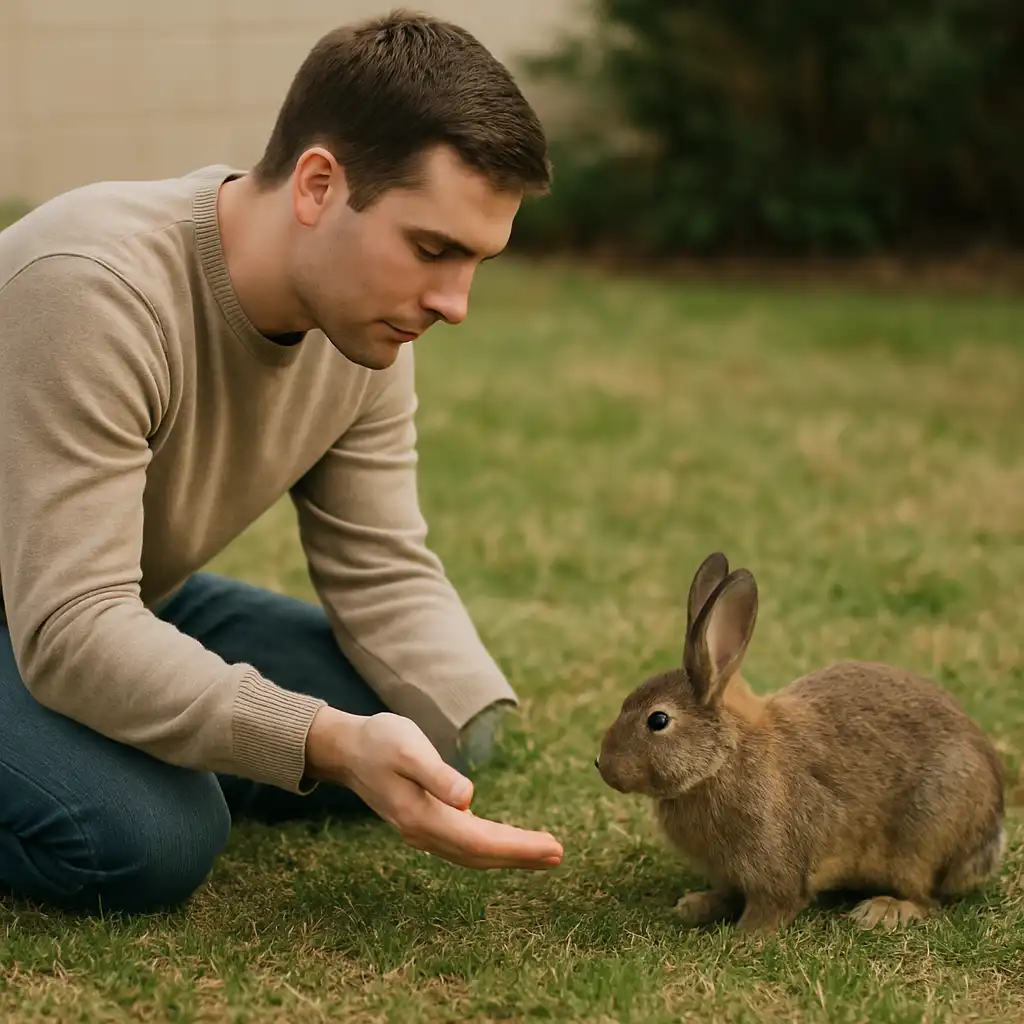Discover effective methods for how to get a rabbit to come to you willingly. This comprehensive guide shares proven techniques from experienced rabbit owners. Learn how to get a rabbit to come to you through proper treat training, environment setup, and trust building. Perfect for new and experienced owners struggling with skittish bunnies. Master how to get a rabbit to come to you consistently with these actionable, expert-backed steps.
Understanding Rabbit Behavior
The first time I tried to get my rabbit Felix to come to me, I made every mistake in the book. I moved too quickly, spoke too loudly, and couldn’t understand why he darted away. Understanding rabbit behavior isn’t just helpful—it’s essential for building the trust needed for your rabbit to come to you willingly. Learning how to get a rabbit to come to you starts with understanding their natural instincts.
Why Rabbits Are Skittish
Rabbits are prey animals, which means their survival instincts are finely tuned to detect and flee from potential threats. This natural wariness isn’t personal—it’s hardwired into their DNA. Understanding natural rabbit behavior patterns is essential when building trust.
“My first rabbit, Coco, would dash under the couch if I even sneezed,” I remember. “It took me weeks to realize that my movements were speaking a language I didn’t understand I was speaking.”
When trying to get a rabbit to come to you, remember:
- Quick movements read as predatory behavior to rabbits
- Loud noises trigger their flight response
- Direct approaches can feel threatening to a bunny
- Looming over them mimics how predators attack
Rabbits have nearly 360-degree vision, but they have a blind spot directly in front of their nose and under their chin. Approaching from these angles can startle them, making them less likely to come to you willingly.
Signs Your Rabbit Likes You
Learning to recognize when your rabbit is comfortable is crucial when encouraging them to approach you. These positive rabbit body language signals will tell you when they’re feeling safe.
When a rabbit feels safe enough to come to you, you’ll notice:
- Soft grinding of teeth (known as “purring”)
- Flopping onto their side near you
- “Binkying” (happy jumps and twists) in your presence
- Gentle nudging with their nose
- Sitting with their feet tucked under them
“The first time Mochi flopped next to me while I was reading, I nearly cried,” I remember. “It wasn’t just cute—it was her telling me she finally felt safe enough to be vulnerable around me.”
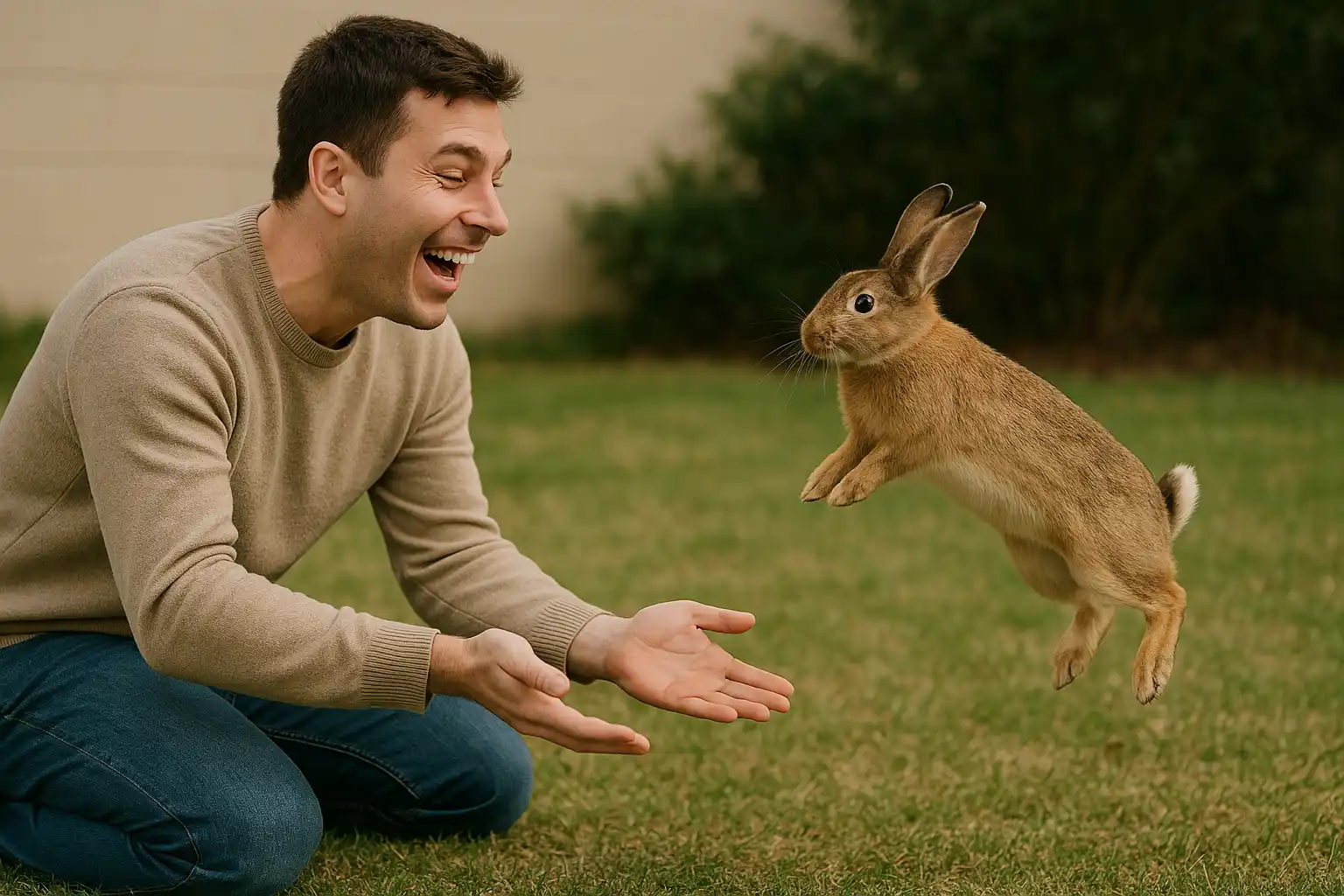
Importance of Trust in Rabbit Training
Trust isn’t just a nice-to-have with rabbits—it’s the foundation of any successful attempt to get your rabbit to come to you. Without it, your bunny will see your attempts at closeness as potential threats.
Trust-building is not linear with rabbits. There were days when my rabbits seemed to regress, hiding from me after weeks of progress. This is normal, and understanding that trust-building has ups and downs will help you stay patient.
“I remember feeling like I’d failed when Pepper suddenly stopped coming to me after two weeks of progress,” I share. “My vet later explained that rabbits, like people, have off-days, and rebuilding trust is sometimes part of the process when you’re trying to get a rabbit to come to you consistently.”
Techniques to Attract Your Rabbit or Bunny
Once you understand rabbit behavior, you can use targeted techniques to encourage your rabbit to come to you.
Using Treats to Lure Your Rabbit
Food is a powerful motivator when you’re trying to get a rabbit to come to you. Learning how to get a rabbit to come to you using treats is relatively straightforward, but not all treats are created equal—both in terms of healthiness and effectiveness. For optimal health, refer to our guide on safe rabbit treats.
Effective treats for rabbit training include:
- Small pieces of fresh apple (no seeds)
- Tiny bits of banana
- Small pieces of carrot
- Fresh herbs like cilantro or basil
- Commercial rabbit training treats (in moderation)
The key is using these treats strategically when practicing how to get a rabbit to come to you. “I made the mistake of over-treating in the beginning,” I admit. “Felix quickly learned he could get snacks without actually coming all the way to me. Be smarter than I was—make the reward worth the journey.”
To use treats effectively:
- Start by offering treats from your hand while sitting at their level
- Gradually increase the distance they need to travel
- Use a consistent verbal cue like “come” or a gentle clicking sound
- Reward immediately when they approach you
- Keep training sessions under 5 minutes to maintain interest
Remember that treats should never exceed 5% of your rabbit’s daily diet to maintain proper rabbit health.
Creating a Comfortable Environment
Your rabbit won’t come to you if they don’t feel safe in their surroundings. Creating an environment where they feel secure is essential for successful training. Setting up a rabbit-safe play area can make a significant difference in their willingness to approach you.
“When I was trying to get my rabbit Pepper to come to me, I made our bonding space the guest bathroom—no hiding spots, bright lighting, and the echo made every sound amplifying. No wonder she was hesitant!” I learned.
To create an ideal environment for getting your rabbit to approach you:
- Choose a quiet space with minimal distractions
- Sit on the floor rather than looming over them
- Ensure the temperature is comfortable (65-75°F is ideal)
- Provide some hiding spots they can retreat to if they feel insecure
- Use a non-slip surface where they can hop comfortably
- Remove other pets from the area
The perfect training space makes your rabbit feel they have options, which paradoxically makes them more likely to choose coming to you.
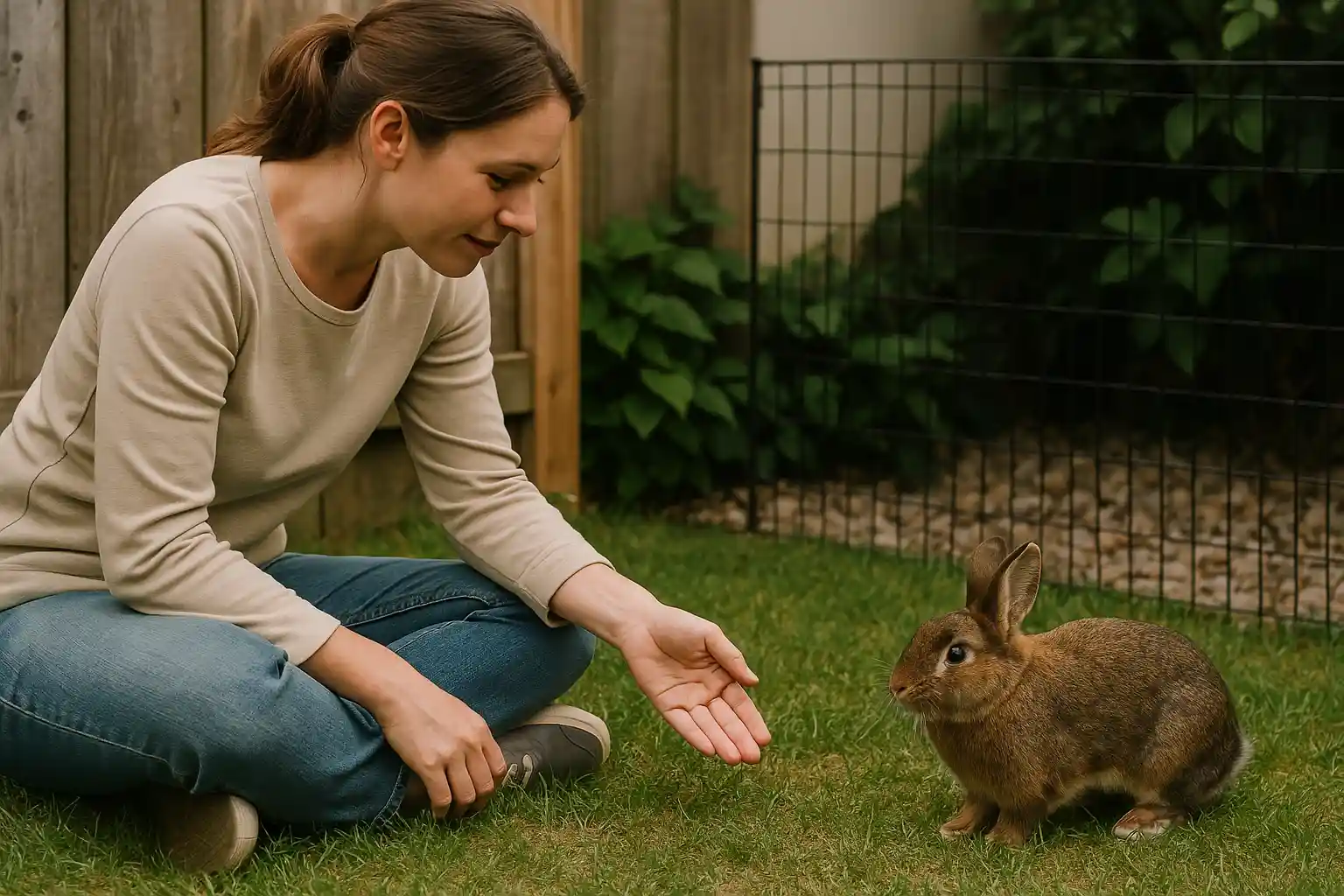
Utilizing Soft Sounds to Gain Attention
Rabbits have extremely sensitive hearing, which you can use to your advantage when encouraging them to come to you.
While loud or sudden noises will send your rabbit running in the opposite direction, consistent, gentle sounds can become a positive association that encourages them to approach.
Effective sound techniques include:
- Softly shaking a small container of pellets
- Gentle clicking sounds with your tongue
- Quietly saying their name in a higher pitch
- Humming very softly
- Crinkling a kale or lettuce bag very gently
“Mochi would come running from anywhere in the house when she heard the specific way I crinkled her greens bag,” I share. “It took weeks of consistency, but eventually, that sound meant ‘good things happen when I go to the human.’ This sound association is one of the most effective methods for how to get a rabbit to come to you reliably.”
The key is consistency—use the same sound each time before offering a treat or affection. Soon, your rabbit will associate that sound with positive experiences and be more likely to come to you when they hear it.
Building a Bond with Your Rabbit
Getting your rabbit to come to you isn’t just about techniques—it’s about establishing a genuine connection that makes them want to be near you.
Spending Quality Time Together
The more positive time you spend with your rabbit, the more likely they are to approach you voluntarily. But “quality” is the operative word here.
“I used to think that just being in the same room as Felix counted as bonding time,” I recall. “But I wasn’t actually engaging with him—I was just physically present while mentally absent on my phone. Real connection requires real attention.”
Quality time with your rabbit includes:
- Reading aloud while sitting near their space
- Working or studying on the floor near them
- Sitting quietly and allowing them to investigate you
- Being present during their active hours (dawn and dusk)
- Respecting their space when they retreat
Remember, forced interaction isn’t bonding—it’s stress. When trying to get a rabbit to come to you, patience is more important than persistence.
Engaging in Play with Your Rabbit
Play not only strengthens your bond but also creates positive associations that make your rabbit more likely to approach you. Check out our rabbit products ideas for inspiration on engaging activities.
Rabbit-appropriate games include:
- Rolling toys for them to chase
- Creating cardboard tunnels to explore
- Setting up obstacles they can jump over
- Hiding treats for them to find (while you sit nearby)
- Providing paper or rabbit-safe branches to shred
“Pepper was a natural athlete who loved jumping,” I remember fondly. “When I created mini hurdles from rolled-up towels, she’d leap over them and then run back to me as if showing off. Play became our language.”
Through play, your rabbit learns that good things happen in your presence, making them more likely to come to you voluntarily. Interactive play is an underrated technique when learning how to get a rabbit to come to you without forcing interaction.
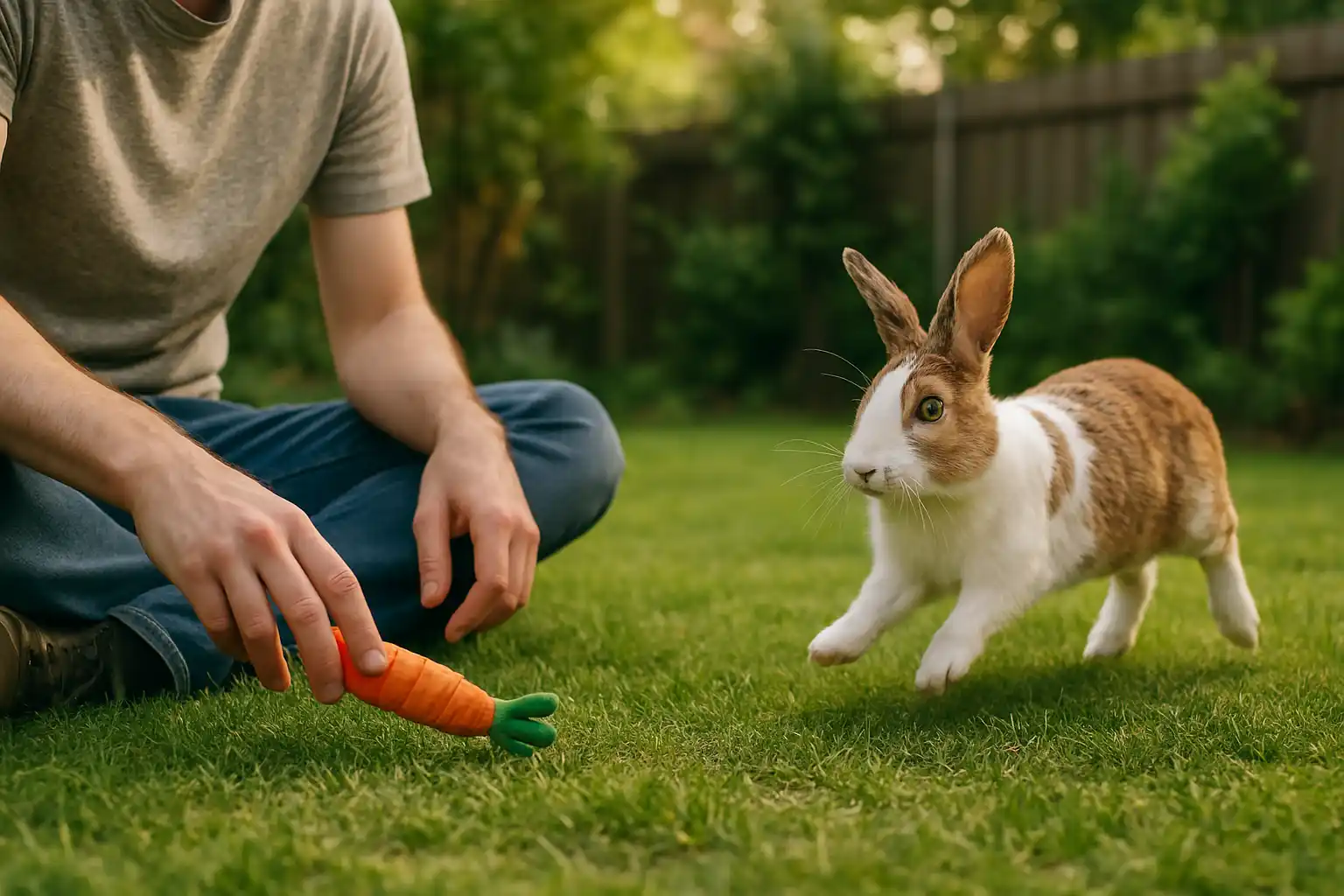
Consistency in Approach and Handling
Rabbits thrive on routine and predictability. When your behavior is consistent, it helps them feel secure enough to approach you.
Consistency includes:
- Approaching them the same way each time
- Using the same verbal cues consistently
- Handling them gently and predictably
- Feeding and treating at regular times
- Respecting their boundaries consistently
“I noticed that Mochi was more willing to come to me when I sat in the same spot each evening,” I share. “Rabbits are creatures of habit—they’re more likely to approach you when they can predict what will happen next. This predictability is crucial when mastering how to get a rabbit to come to you without causing stress.”
This consistency extends to everyone in the household. Make sure family members understand the approach you’re using to get your rabbit to come to you, or your bunny may receive mixed signals.
Common Mistakes to Avoid
In my years of rabbit ownership, I’ve made plenty of mistakes that temporarily damaged trust. Learning from these can help you avoid setbacks in getting your rabbit to come to you.
Overreacting to a Rabbit’s Fear
When your rabbit shows fear, it’s natural to want to comfort them—but human comfort often looks like predatory behavior to rabbits.
“When Coco was spooked by a loud noise, I’d rush over to soothe her,” I remember. “I couldn’t understand why this made her more afraid until I realized that to her, my quick movements and hovering looked like a hawk swooping in.”
Instead of rushing to comfort a frightened rabbit:
- Stay still and speak softly
- Lower your body to appear less threatening
- Allow them to approach you when ready
- Maintain a calm environment
- Avoid direct eye contact, which can be intimidating
Remember, building trust means respecting their natural instincts, even when they don’t align with human intuition.
Forcing Interaction with Your Rabbit
The fastest way to ensure your rabbit won’t come to you is by forcing physical interaction before they’re ready. This is particularly important for new rabbit owners who may be eager to bond quickly.
“The hardest lesson I learned was that my timeline didn’t matter,” I admit. “When I tried to speed up bonding with Felix by repeatedly picking him up against his will, I set our relationship back by weeks.”
Signs you might be forcing interaction include:
- Repeatedly picking up a struggling rabbit
- Cornering them to pet them
- Pulling them out of hiding spots
- Continuing to pet when they try to move away
- Restricting their movement to keep them near you
Instead, let your rabbit set the pace of your relationship. When they learn you respect their boundaries, they’ll be more likely to approach you voluntarily. Patience is the secret ingredient when learning how to get a rabbit to come to you successfully.
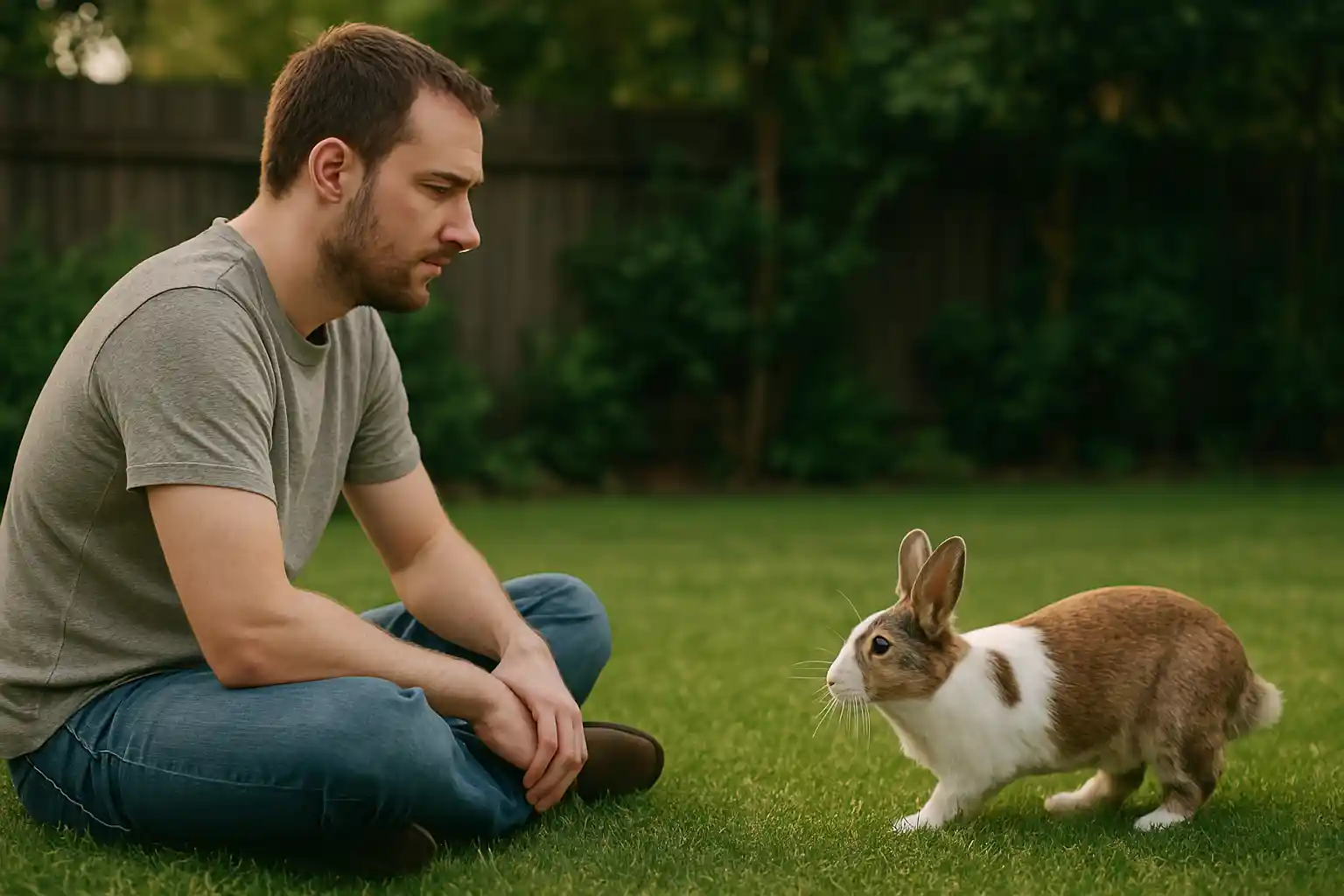
Inconsistent Feeding and Treat Giving
Rabbits thrive on routine, and inconsistent reward systems can confuse them rather than encourage them to come to you.
“My household was working against me when trying to train Pepper,” I share. “I was using pellets as high-value treats during training sessions, but my partner was freely giving them throughout the day. No wonder she was ignoring my training cues!”
Common inconsistencies that hinder training:
- Family members feeding treats randomly throughout the day
- Changing the reward for the same behavior
- Giving treats without the rabbit earning them through approaching
- Inconsistent timing between cue and reward
- Changing the training treat frequently
Establish a household policy on treats and feeding to maintain a consistent approach to getting your rabbit to come to you. This clarity will accelerate your rabbit’s understanding of what earns rewards and strengthen your methods for how to get a rabbit to come to you reliably.
Monitoring Progress
Getting a rabbit to come to you consistently takes time, and progress might be subtle. Learning to recognize and document small wins helps maintain momentum when you’re practicing how to get a rabbit to come to you through positive reinforcement.
Recognizing Changes in Rabbit Behavior
Progress in rabbits isn’t always linear, but there are definite stages you’ll notice as trust builds.
“With Felix, I almost missed the early signs of progress,” I remember. “He wasn’t coming all the way to me, but he was choosing to hang out closer to my side of the room. That was actually huge progress I nearly overlooked.”
Signs your rabbit is becoming more comfortable approaching you:
- Decreased startle response when you enter the room
- Choosing resting spots closer to you
- Brief approaches followed by retreat (testing the waters)
- Curious behavior rather than fearful freezing
- Grooming themselves in your presence (a vulnerable activity)
Each of these behaviors indicates growing trust, even if your rabbit isn’t yet running to you on command. Celebrate these interim steps toward your ultimate goal.
Adjusting Techniques Based on Rabbit Response
Not all rabbits respond to the same approaches, and flexibility is key to success.
“Pepper was incredibly food-motivated, while Mochi responded better to play and attention,” I note. “When I stopped using a one-size-fits-all approach and started tailoring my techniques to each rabbit’s personality, I saw much faster progress.”
Signs you might need to adjust your approach:
- Your rabbit seems afraid of the training treats
- They show more interest in exploring than treats
- They approach others in the household but not you
- They respond to certain sounds but ignore others
- Their interest plateaus or decreases over time
Be willing to experiment with different techniques while maintaining the consistency that rabbits need to feel secure. This balance of consistency and adaptation will help you find the most effective way to get your rabbit to come to you.
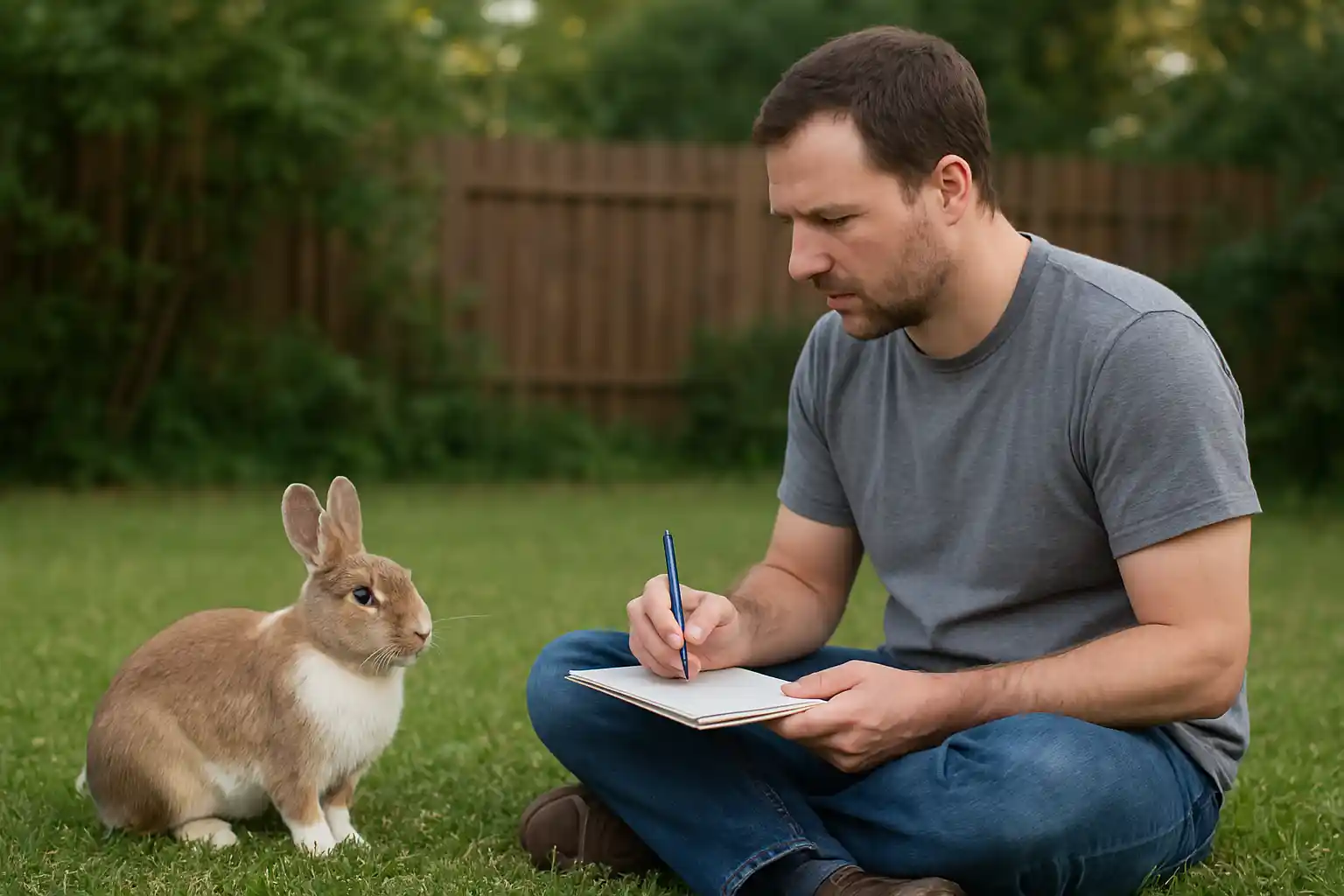
Keeping a Journal of Rabbit Interactions
One of the most helpful tools in my rabbit training journey was keeping a simple journal of our interactions.
“I thought I’d remember what worked and what didn’t, but rabbit training is so subtle that without notes, I was missing patterns,” I share. “When I started documenting our sessions, I realized Felix was more likely to come to me in the evening and virtually never in the early afternoon.”
A simple rabbit interaction journal might track:
- Time of day and training duration
- Treats or toys used
- Environment conditions (quiet vs. noisy, etc.)
- Your rabbit’s body language
- How close they came to you
- How long they stayed nearby
- Any distractions or disruptions
This documentation helps identify patterns that might not be obvious in the moment, allowing you to optimize your approach to getting your rabbit to come to you.
FAQ About Getting Rabbits to Come to You
How long does it typically take to train a rabbit to come when called?
Most rabbits require 3-8 weeks of consistent training to reliably come when called. Shy rabbits may take longer—patience is key.
Is it normal for my rabbit to come to me sometimes but not others?
Yes, this is completely normal. Rabbits have different moods daily. Factors like noise, recent experiences, and even barometric pressure affect their approach behavior.
How do I get my bunny to follow me?
To get your bunny to follow you, start by building trust through daily interaction and gentle handling. Use soft voice cues and reward them with treats when they move toward you. Over time, your bunny will associate you with positive experiences and be more likely to follow you naturally.
Can I use a clicker to train my rabbit to come to me?
Clicker training works well with rabbits. Click the instant your rabbit moves toward you, then immediately give a treat to reinforce the behavior.
Learning how to get a rabbit to come to you is one of the most rewarding parts of rabbit ownership, but it requires understanding, patience, and respect for their natural behaviors. By following these techniques and avoiding common mistakes, you’ll build the trust needed for your bunny to approach you willingly. With consistent practice, you’ll master how to get a rabbit to come to you even in different environments.
Want to learn more about rabbit ( Bunny ) behavior? Check out our complete guide to rabbit body language to better understand what your bunny is trying to tell you. And if you’re interested in teaching your rabbit other tricks, our training basics guide is the perfect next step.

